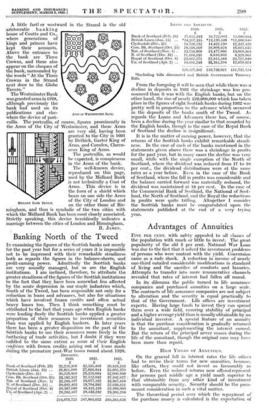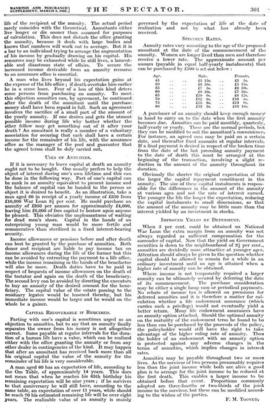Advantages of Annuities
FIVE ma CENT. with safety appealed to all classes of the population with much or little to invest. The great popularity of the old 5 per cent.. National War Loan was due to the fact that it solved the investment problems of persons who were content with the yield. Conversion came as a rude shock. A reduction in income of nearly one-third entailed considerable modifications in standard of, living and the sacrifice of comforts and luxuries. Attempts to transfer into more remunerative channels revealed that rates of interest had fallen all round.
In its dilemma the public turned to life assurance companies and purchased annuities on a large scale. The contracts of life assurance companies are not subject to alteration and the security is equal practically to that of the Government. Life offices are investment experts. Having large funds to invest they can spread them over a wide field, ensuring stability of principal and a higher average yield than is usually obtainable by an individual investor. A special feature of an annuity is that the purchase consideration is gradually returned to the annuitant, supplementing the interest earned. But the return of the principal never ceases during the life of the annuitant, though the original sum may have been more than repaid.
Thou YIELDS Or ANNUITIES.
On the general fall in interest rates the life offices had to revise their terms for new annuities, because, like others, they could not invest so favourably as before. Even the reduced returns now offered represent for persons past middle age a yield much superior to that obtainable from any other kind of investment with comparable security. Security should be the para- mount consideration in such a vital matter.
The theoretical period over which the repayment of the purchase money is calculated is the expectation of life of the recipient of the annuity. The actual period rarely coincides with the theoretical. Annuitants either live longer or die sooner than assumed for purposes of calculation. This does not disturb the office granting the annuity, because it deals with large bodies and knows that numbers will work out to average. But it is a bar to an individual trying to arrange the augmentation of his income by gradually drawing on his capital. His resources may be exhausted while he still lives, a lament- able and disastrous state of affairs. To secure the increased income derivable from an annuity recourse to an assurance office is essential.
A man who lives beyond his expectation gains at' the expense of the life office ; if death overtake him earlier he in a sense loses. Fear of a loss of this kind deters some persons from purchasing an annuity. To meet this objection annuities can, by agreement, be continued after the death of the annuitant until the purchase money shall have been repaid in full. Such an agreement involves the sacrifice of a small part of the amount of the yearly annuity. If one desires and gets the utmost possible income during life why bother whether the other fellow may get something out of it after your death ? An annuitant is really a member of a voluntary; association for securing that each shall have a certain income for the remainder of his life, with the assurance office as the manager of the pool and guarantor that the agreed terms shall be duly carried out,
USES OF ANNUITIES.
If it is necessary to leave capital at death an annuity ought not to be bought. One usually prefers to help the object of interest during one's own lifetime and this can be done in the following way. Part of one's capital can be sunk in an annuity equivalent to present income and the balance of capital can be handed to the person or object it is desired to benefit. As an illustration, take a man aged 60 in receipt of a yearly income of £350 from £10,000 War Loan 8i per cent. He could purchase an annuity rof £850 per annum for approximately £4,000, leaving him £6,000 of free capital to bestow upon anyone he pleased. This obviates the unpleasantness of waiting for dead men's shoes. Capital in the hands of an enterprising young man would be more fertile and remunerative than sterilized in a fixed interest-bearing security.
Income allowances or pensions before and after death can best be granted by the purchase of annuities. Both donor and recipient are liable to pay income tax on income allowances during the life of the former but this can be avoided by entrusting the payment to a life office, while the income remaining in the hands of the benefactor will also be more. Death duties have to be paid in respect of bequests of income allowances on the death of the testator and again on the death of the beneficiary. The second levy can be avoided by directing the executors to buy an annuity of the desired amount for the bene- ficiary. The capital value of the estate passing to the residuary legatee would be lessened thereby, but his immediate income would be larger and he would on the whole be a gainer.
CAPITAL RECOVERABLE IF REQUIRED.
Parting with one's capital is sometimes urged as an objection to annuities, but to say that an annuity finally separates the owner from his money is not altogether correct. Sums payable at regular intervals for the dura- tion of a human life have a value, which can be realized either with the office granting the annuity or from any other dealer in contingencies of the kind. It may happen that after an annuitant has received back more than all his original capital the value of the annuity for the remainder of his life is very considerable.
A man aged 60 has an expectation of life, according to the Om Table, of approximately 14 years. This does not mean that when he reaches his 65th birthday his remaining expectation will be nine years ; if he survives to that anniversary he will still have, according to the same table, an expectation of over 11years while should he reach 70 his estimated remaining life will be over eight years. The realizable value of an annuity is mainly governed by the expectation of life at the date of realization and not by what has already been received.
SPECIMEN RATES.
Annuity rates vary according to the age of the proposed annuitant at the date of the commencement of the annuity. Women are longer lived than men and therefore receive a lower rate. The approximate amount per annum (payable in equal half-yearly instalments) that can be purchased by £100 is set out below :
Age.
Male. Female.
45
£5 15s.
£5 5s.
50 £6 10s. £5 15s.
55
£7 5s,
£6 10s.
60 £810e. £7 1Qs.
65 £10 Os. .. £8 12s.
70 . £10 5s.
75 .. £15 8s. .. Os.
80 . - .. £19 9s. .. £16 16s.
A purchaser of an annuity should keep enough money in hand to carry on to the date when the first annuity becomes due. Annuities can be paid monthly, quarterly, half-yearly or yearly. These are the normal periods, but they can be modified to suit the annuitant's convenience., For instance, an agreed sum may be paid on a certain date, and thereafter fixed amounts at regular intervals. If a final payment is desired in respect of the broken time from the date of the last preceding annuity payment to the date of death this must be arranged at the beginning of the transaction, involving a slight re- duction in the amount of the annuity throughout its duration.
Obviously the shorter the original expectation of life the larger the capital repayment constituent in the annuity. The size of these capital instalments is respon- sible for the differences in the amount of the annuity at various ages and not the rate of interest earned. The younger the life the longer the expectation, reducing the capital instalments to small dimensions, so that the amount of the annuity may be little more than the interest yielded by an investment in stocks.
IMPROVED YIELDS BY DEFERMENT.
When 5 per cent. could be obtained on National War Loan the extra margin from an annuity was not always regarded as sufficient compensation for the surrender of capital. Now that the yield on Government securities is down to the neighbourhood of 81 per cent., annuities are decidedly more attractive at younger ages. Attention should always be given to the question whether capital should be allowed to remain for a while in an ordinary investment until an age is attained when a higher rate of annuity can be obtained.
Where income is not temporarily required a larger annuity can be ultimately secured by deferring the date of its commencement. The purchase consideration may be either a single lump sum or periodical payments. No rebate of income tax is allowed on premiums for deferred annuities and it is therefore a matter for cal- culation whether a life endowment assurance (which carries such a privilege) would not eventually yield a better return. Many life endowment assurances have an annuity option attached. Should the optional annuity on the maturity of the endowment term be found to be less than can be purchased by the proceeds of the policy, the policyholder would still have the right to take advantage of the higher ruling rate of annuity. Thus the holder of an endowment with an annuity option is protected against any adverse changes in the terms of annuities, which implies changes in interest rates.
Annuities may be payable throughout two or more lives. As the survivor of two persons presumably requires less than the joint income while both are alive a good plan is to arrange for the joint income to be reduced at the first death. This enables a larger income to be obtained before that event. Proportions commonly adopted are three-fourths or two-thirds of the joint income to the survivor, but these can be modified accord- ing to the wishes of the parties.
F.' M. TOOVEYA



















































 Previous page
Previous page